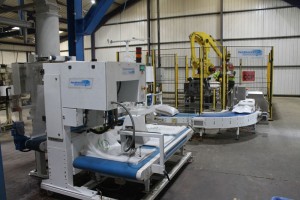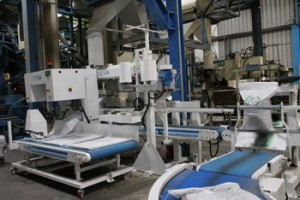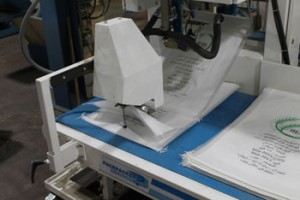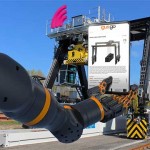New robotic line boosts productivity by 20%
 Askew & Barrett sources pulses from key agricultural merchants and then sorts, cleans and grades them at its processing plant in Wisbech, Cambridgeshire. The pulses are bagged into 12.5kg and 25kg paper sacks and 25kg woven polypropylene (WPP) sacks, before being palletised and transported to food manufacturers and retailers at home and abroad.
Askew & Barrett sources pulses from key agricultural merchants and then sorts, cleans and grades them at its processing plant in Wisbech, Cambridgeshire. The pulses are bagged into 12.5kg and 25kg paper sacks and 25kg woven polypropylene (WPP) sacks, before being palletised and transported to food manufacturers and retailers at home and abroad.
Pictured right: Within three months the packing and palletising line at Askew & Barrett has boosted productivity by 15-20%
Until very recently, this entire operation, from empty bag placement to palletising, was performed by up to five operators, with a weigher, bag closer and stitcher the only pieces of equipment to figure.
The problem was that in order to keep up with demand, during busy periods Askew & Barrett had to operate the line 24 hours a day, six days a week. Although the working day was split into either two 12 hour or three eight hour shifts, this was still physically demanding work, and the company didn’t want to continue exposing its staff to that level of manual handling.
“It takes it out of you standing at the end of the line, stacking sacks onto a pallet. We wanted to take steps to ensure the physical wellbeing of our employees,” explains production and warehouse manager Chris Askew.
Askew & Barrett engaged Pacepacker to design a fully automated packing and palletising line that would reduce manual handling and increase productivity.
The line, which includes a T22 automatic sack placer, ticket dispenser, Total Bag Control (TBC) system and FANUC dual cell robot palletiser, was installed in February this year. It has increased line speed with a potential of 10 bags per minute, and will in time, hopefully enable the company to reduce the working week from six days to five without laying anyone off – staff have been redeployed to less physical tasks. Chris also reports that bags are now stacked more consistently onto pallets allowing for much safer storage within Askew & Barrett’s warehouse and loading these pallets onto containers has become much easier.
“Pacepacker has delivered everything we wanted – building a line that has eliminated the need for manual involvement and has already yielded double digit productivity improvements,” he says.
Overcoming obstacles
 The project was not without its challenges: space was limited and Askew & Barrett had stipulated that they wanted to maintain good, clear access for forklift trucks.
The project was not without its challenges: space was limited and Askew & Barrett had stipulated that they wanted to maintain good, clear access for forklift trucks.
Pictured left: To make the most of the available space, Pacepacker configured the TBC to kick bags off at 90 degrees and then transport them round a corner rather than in a straight line
“We worked closely with the customer to configure the line to fit in the available space. For example, we designed the TBC to kick bags off at 90 degrees and then transport them round a corner rather than in a straight line,” says Pacepacker sales manager Ian Merchant.
WPP is always a potential issue for sack placers, which use a vacuum to pick up the bag on the top of the pile. WPP bags with a loose weave, like the ones at Askew & Barrett, prevent the vacuum system from working properly.
However, through its experience with sack applications, Pacepacker has developed a tail separator that ensures the sack placer only takes one bag at a time. “We use a high volume vacuum system to pick up the bags, however due to the porous nature of WPP bags there is the potential that more than one bag will be picked up. Therefore the tail separator lifts the tail end of the bag – the closed part – and holds it in place while it is rotated by 45 degrees and transported to the clamp for filling.” Explains Ian Merchant.
 Pictured right: the tail separator lifts the tail end of the bag – the closed part – and holds it in place for filling
Pictured right: the tail separator lifts the tail end of the bag – the closed part – and holds it in place for filling
After being placed on a clamp by the sack placer, sacks are filled and taken through the TBC system – a fully automated presentation device for feeding filled bags into a fixed head stitcher or heat sealer.
As the bag drops from the clamp, motorised grip arms close in on it, securing it in its formed state. These arms release the bag into a twin belt feeder where an integrated ticket dispenser inserts a tag with batch data, best before date and origin just before the bag is stitched.
“Because it never lets go of the bag until it has been stitched, the TBC ensures consistently perfect presentation, which in turn eliminates sack and product waste,” explains Ian.
Pacepacker also integrated a Loma IQ3 metal detector into the line and designed an automatic reject system for diverting contaminated bags. The metal detector is located just prior to the robot pick point for screening the smaller bags for metal. If metal is detected, as the sack rolls onto the pick conveyor, a stop gate lowers to allow it to pass onto a reject conveyor.
Askew & Barrett opted for a dual cell robotic palletiser, incorporating the FANUC M410iC/185, for maximum performance. In a dual cell configuration, the robot is sited so that it can swivel between two cells. This means that as soon as the robot has finished palletising a stack, it starts to palletise on the other pallet in the cell.
“This is an extremely time-efficient configuration as the robot is always in use – it can start loading a new pallet while the full pallet is being transported to the delivery area,” says Ian.
Askew & Barrett has another reason for wanting a dual cell palletiser; the company is looking to replace an adjacent packing line with a Pacepacker TBC system, and link the two lines at the point of palletising, so that they can both be serviced by the existing palletiser.
Chris is confident that with Pacepacker’s continued support, this upgrade will further increase productivity. “Currently, the line is producing 10 tonnes per hour, but it is definitely capable of much more,” he says. “Our ultimate goal is 15-20 tonnes per hour, which would equate to a 100% increase on what we were producing just a few months ago. Pacepacker has been and will continue to be instrumental in achieving this ambition.”
Visit the Pacepacker Services website for more information.
See all stories for Pacepacker Services















